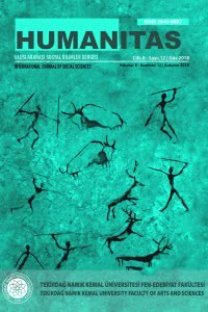PHILIP RIDLEY’İN KÜRKLÜ MERKÜR ADLI OYUNUNDA LABİRENTİMSİ MEKANIN TEMSİLİ
Bu çalışma, Philip Ridley’in bir labirent olarak hafıza ve ayna olarak labirent gibi fiziksel labirent ile bağlantılı çeşitli anlamları inceleyen Kürklü Merkür (2005) adlı oyununa odaklanmaktadır. Bu çalışma, öncelikle Ridley’in oyununda Foucault’nun “heterotopya”sını hatırlatan bir şekilde radikal bir alan olarak yansıtılan ve karakterlere yersizliğin ve yönsüzlüğün musallat olduğu fiziksel labirentin önemini ortaya koymayı amaçlar. Karakterlerin kaçınılmaz tutsaklığı onlarda bir varoluşsal kaygı yaratır. Bu çalışma ayrıca labirent olarak hafıza kavramını tartışarak milli ya da bireysel kimlikler konu edilirken oyun yazarının hafızanın güvenilmezliğine dair vurgusunu ortaya koyar. Herkesin ve her şeyin manipüle edildiği bir alanda varoluş mücadelesi veren Ridley’in karakterleri, kendilerini insanlığa ve ahlaka götüren yolu keşfetmek için bilinen bütün zalimlik ve yoldan çıkma eşiklerini yeniden değerlendirmeye zorlanırlar.
Anahtar Kelimeler:
Philip Ridley, Labirent, heterotopya, hafıza, gerçeklik, Kürklü Merkür
THE LABYRINTHINE SPACE AS REFLECTED IN PHILIP RIDLEY’S PLAY MERCURY FUR
This study focuses on Philip Ridley’s Mercury Fur (2005), a play which explores various meanings related to a physical labyrinth, memory as a maze, mirror/glass as a labyrinth, etc. The present study aims to disclose primarily the significance of the physical labyrinth, presented in Ridley’s play mostly as a radical space, a reminiscent of Foucault’s “heterotopia”, in which the characters cannot be domiciled, but are rather haunted, their inevitable entrapment creating a perpetual existential feeling of anxiety. This study also attempts to discuss the issue of memory as a maze, revealing the playwright’s concern for the precariousness of memory while the national or individual identities are pursued. In a space in which everyone and everything is manipulated, Ridley’s characters, in their struggle for survival, are forced to re-negotiate all the known thresholds of cruelty and transgression in order to discover the path leading them to humanness and morality.
Keywords:
Labyrinth, heterotopia, memory, reality, Philip Ridley, Mercury Fur,
___
- Attinger, C. (2017). Staging Hobbes, or: Theseus goes to the theatre. Precariousness, cultural memory and dystopia in Philip Ridley’s Mercury Fur. In M. Aragay & M. Middeke (Eds.). Of precariousness: vulnerabilities, responsibilities, communities in 21st-century British drama and theatre (pp. 47-62). London: De Gruyter, Inc.
- Augé, M. (1992). Non-lieux. Introduction à une anthropologie de la surmodernité. Paris: Ed. Du Seuil.
- Baudrillard, J. (1994). Simulacra and simulation. Ann Arbor: University of Michigan Press.
- Everyman, R. (2004). The past in the present: culture and the transmission of memory. Acta Sociologica, 47(2), 159-169.
- Foucault, M. (2008). Of other spaces. In M. Dehaene & L. De Cauter (Eds.). Heterotopia and the city: public space in a postcivil society (pp. 13-29). London: Routledge.
- Fukuyama, F. (2002). Our posthuman future. Consequences of the biotechnology revolution. New York: Farrar, Straus and Giroux.
- Gane, M. (1991). Baudrillard: critical and fatal theory. London: Routledge.
- Golban, T. & Benli, D. (2017). The quest for an authentic self: memory and identity in Philip Ridley’s Mercury Fur. Border Crossing, 7, 305-316.
- Harpin, A. (2011). Intolerable acts. Performance Research, 16(1), 102-111.
- Kern, H. (2000). Through the labyrinth: designs and meanings over 5,000 years. New York: Prestel Publishing.
- Ricoeur, P. (2004). Memory, history, forgetting. Chicago: The University of Chicago Press.
- Schmitz-Evans, M. (2012). Mirror and Labyrinth. In G. Lehnert & S. Siewert (Eds.). Spaces of desire- spaces of transition: space and emotions in modern literature (pp. 15-27). Hamburg: Peter Lang.
- Sudradjat, I. (2012). Foucault, the other spaces, and human behaviour. Procedia - Social and Behavioral Sciences, 36, 28-34.
- Wyllie, A. (2013). Philip Ridley and memory. Studies in Theatre and Performance, 33(1), 65-75.
- ISSN: 2147-088X
- Yayın Aralığı: Yılda 2 Sayı
- Başlangıç: 2013
- Yayıncı: Namık Kemal Üniversitesi
Sayıdaki Diğer Makaleler
AKTÖREL SEYİR VE AV: SOSYAL BEDEN KARŞISINDA ÇIPLAK BEDENİN EGEMEN OYUNU
PATRICK MCCABE’İN THE BUTCHER BOY ADLI ROMANINDA KÖTÜCÜL NOSTALJİ
SOSYOLOJİDE POZİTİVİST KURAMIN TOPLUMSAL OLAYLARA YAKLAŞIMI, FELSEFİ VE SINIFSAL TEMELLERİ
Aslı Eda DÜNDAR, Veda ASLIM YETİŞ
JOHN FISKE VE POPÜLER KÜLTÜR: MARGARET TYLER’IN “OKUYUCUYA MEKTUP”UNUN ELEŞTİREL BİR OKUMASI
RUMELİ DEMİRYOLLARI EGE DENİZİ BAĞLANTI HATTINDA YENİ BİR LİMAN KENTİ: DEDEAĞAÇ (1872-1912)
BATILAŞMA DÖNEMİNDE İSTANBUL’DA RUM CEMAATİNİN EĞİTİMİ
KEDERLİ VE KEDERLİ OLMAYAN YAŞAMLAR: PHIL KLAY’IN REORGANİZASYONU
